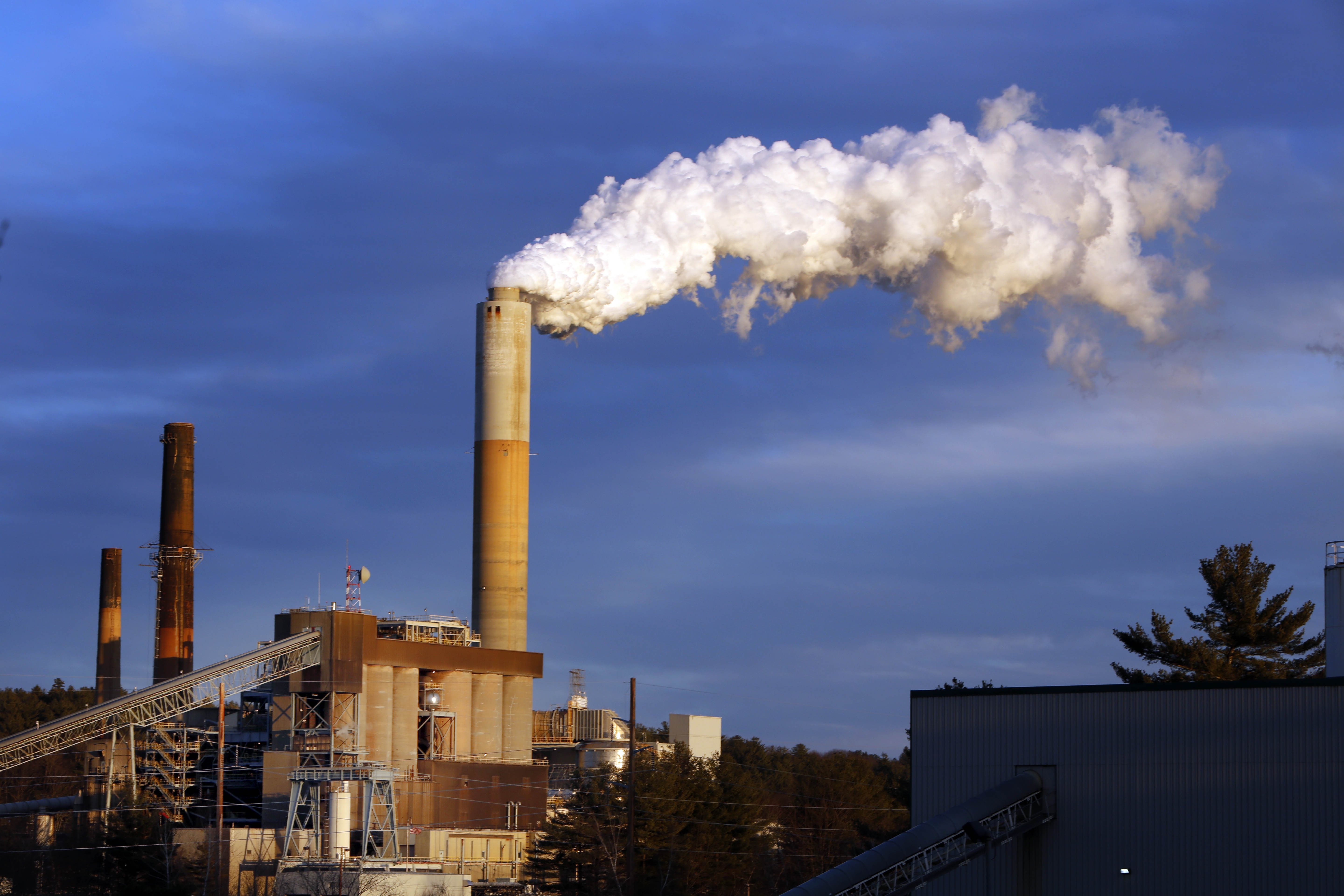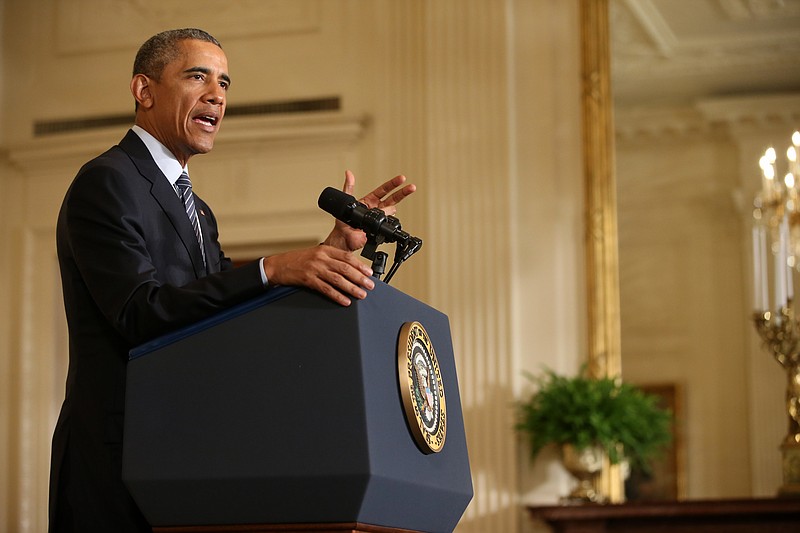WASHINGTON -- Calling it a moral obligation, President Barack Obama unveiled the final version of his plan to dramatically cut emissions from U.S. power plants, as he warned anew that climate change will threaten future generations if left unchecked.
Touting the plan at a White House event on Monday, Obama said the unprecedented carbon dioxide limits are the "the single most important step" America has ever taken to fight climate change. He warned that because the problem is so large, if the world doesn't get it right quickly, it may become impossible to reverse, leaving populations unable to adapt.
"There is such a thing as being too late when it comes to climate change," Obama said.
The carbon controls outlined by the U.S. Environmental Protection Agency mandate even steeper greenhouse gas cuts from U.S. power plants than previously expected. But the new rules give the Tennessee Valley Authority a big advantage over the draft proposal issued a year ago.
Under the new rules, TVA will be able to count the new Unit 2 reactor it is building at the Watts Bar Nuclear Plant near Spring City, Tenn., as part of its carbon reductions. Previously, the EPA had said TVA couldn't count the new unit since it was started back in the 1970s, long before the new rules were ever developed.
 FILE - In this Jan. 20, 2015 file photo, a plume of steam billows from the coal-fired Merrimack Station in Bow, N.H. President Barack Obama on Monday, Aug. 3, 2015, will unveil the final version of his unprecedented regulations clamping down on carbon dioxide emissions from existing U.S. power plants. The Obama administration first proposed the rule last year. Opponents plan to sue immediately to stop the rule's implementation. (AP Photo/Jim Cole, File)
FILE - In this Jan. 20, 2015 file photo, a plume of steam billows from the coal-fired Merrimack Station in Bow, N.H. President Barack Obama on Monday, Aug. 3, 2015, will unveil the final version of his unprecedented regulations clamping down on carbon dioxide emissions from existing U.S. power plants. The Obama administration first proposed the rule last year. Opponents plan to sue immediately to stop the rule's implementation. (AP Photo/Jim Cole, File)TVA estimates it has already cut its carbon emissions by 30 percent since 2005 by closing old coal-fired power plants and replacing that power with more natural gas, nuclear, wind, solar and hydroelectric generation. Under its long-term power plan known as the Integrated Resource Plan, TVA expects to make further cuts in carbon emissions by closing its Widows Creek, Colbert, Johnsonville and Allen steam plants and by cutting operations at Paradise Fossil Plant prior to 2022 when the carbon reductions must be made.
"We believe that TVA's 2015 integrated resource plan sets us up well for the future," TVA spokesman Scott Brooks said Monday. "Its flexibility allows us to meet new regulations and changing market conditions with decreasing carbon dioxide emissions."
Brooks said TVA is still reviewing more than 1,000 pages of regulations issued by EPA Monday in the final version of the Clean Power Plan. But those who worked on the a new power plan for TVA's future expect the federal utility to have little difficulty meeting the new standards, depending upon how the seven states that TVA serves implement the new rules.
"TVA is well positioned and is some ways ahead of many utilities in limiting its carbon emissions and preparing for these changes," said Stephen Smith, executive director of the Southern Alliance for Clean Energy and a member of TVA's advisory board that reviewed the utility's new Integrated Resource Plan. "We would hope that some of the incentives in this plan for those that move early with measures for more energy efficiency and renewables will help push TVA to move quicker on some of these initiatives. But there is certainly no evidence that this will cause any great job loss or economic disruption in Tennessee."
Although coal jobs will continue to shrink, Smith said clean energy jobs from solar, wind and energy efficiency will continue to increase. Environmental Entrepreneurs, or E2, estimates that Tennessee added 2,600 jobs last year by employers operating in the energy-efficiency, renewable-energy, clean-transportation, and greenhouse-gas management and accounting sectors.
But one of TVA's former chairman, Mike Duncan, insists that the new carbon controls will cost thousands of U.S. jobs and hurt manufacturing by driving up the cost of energy.
"With the release of the final carbon regulation, the President once again demonstrated his lack of empathy for hard working Americans across the country who first and foremost wish to secure a robust economic future," said Duncan, who is now president and CEO of the American Coalition for Clean Coal Electricity. "Even in the face of damning analyses and scathing opposition from across the country, EPA's final carbon rule reveals what we've said for months this agency is pursuing an illegal plan that will drive up electricity costs and put people out of work."
The Tennessee Electric Cooperative Association, which represents TVA distributors that serve more than 1 million Tennesseans, said the Clean Power Plan "fails to consider the impact to electric rates and reliability."
"We are disappointed that the EPA continues to ignore the burden these regulations will have on Tennessee families and businesses," said David Callis, general manager of the Tennessee Electric Cooperative Association.
National Association of Manufacturers President and CEO Jay Timmons said the regulations "will be exceptionally difficult for manufacturers to meet and will increase energy prices and threaten electric reliability." U.S. Chamber of Commerce CEO Thomas J. Donohue said the EPA rules "will inflict significant damage to our entire economy and reduce our nation's global competitiveness without any significant reduction in global greenhouse gas emissions."
Opponents immediately announced they would sue the government to stop the rules from taking effect. West Virginia Attorney General Patrick Morrisey, speaking at a summit of Republican state attorneys general, said West Virginia would be among a group of states "launching an aggressive legal campaign."
"Their legal foundation is very, very shaky," Morrisey said of the Obama administration. "We are confident that we will prevail."
Many Republican-led states have said their states simply won't comply. Senate Majority Leader Mitch McConnell, who has encouraged GOP governors to take that step, vowed to use legislation to thwart the president's plan.
The pollution controls form the core of Obama's ambitious and controversial plan to drastically reduce overall U.S. emissions, as he works to secure a legacy on fighting global warming. Yet it will be up to Obama's successor to implement his plan, which has attracted strong opposition from the field of Republican presidential candidates.
The Obama administration estimated the emissions limits will cost $8.4 billion annually by 2030. The actual price won't be clear until states decide how they'll reach their targets. But energy industry advocates said the revision makes Obama's mandate even more burdensome, costly and difficult to achieve.
Power plants account for roughly one-third of all U.S. emissions of the heat-trapping gases blamed for global warming, making them the largest single source. Already Obama has curbed greenhouse gas emissions from other major sources, including cars and trucks.
The final version of Obama's plan imposes stricter carbon dioxide limits on states than was previously expected: a 32 percent cut by 2030, compared with 2005 levels, the White House said. Obama's proposed version last year called only for a 30 percent cut.
EPA estimates that the Clean Power Plan will prevent up to 3,600 premature deaths and 90,000 asthma attacks in 2030, as well as prevent 300,000 missed days of work and school.
